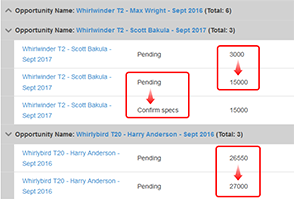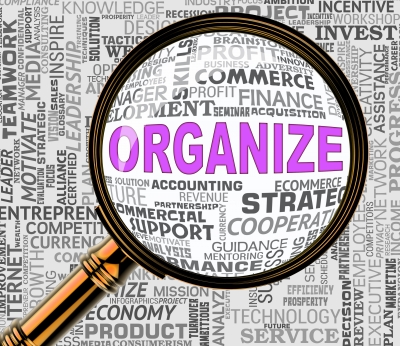
It’s nearly impossible to go a waking hour without interacting with technology.
Smartphones, software, emails, social media, apps, text messages, websites….everywhere you look, another innovative gadget is enhancing life as we know it.
For technology entrepreneurs like you, this is great news. Consumers and businesses alike are hungry for the next game-changing tool. This hunger, however, has been known to rapidly cause confusion within your company. Leads, contacts, opportunities, and projects are everywhere in your CRM. Surely there’s a better way to keep everything organized.
If you’re an Insightly user, you may have considered leveraging tags to a greater extent. In this post, I’ll share a few tips for tagging your records to yield better CRM value.
- Understand the Difference Between Tags & Fields
Before you let your sales team run loose and start tagging everything in sight, it’s important to first understand the difference between tags and fields. Stop and think about how you currently use your CRM. If you’re like most companies, you probably spend most of your time in one or more of these records:
- Contacts
- Opportunities
- Leads
- Organizations
- Emails
- Projects
When working with these records, you may have noticed that Insightly prompts you to enter certain pieces of information. For example, when entering a contact record, you can choose to input: name, occupation, email address, phone number, website, social media profiles, and background information. Such data is standard across all of your contact records, which makes filtering a breeze.
As time goes on, you may realize that adding custom fields could also be beneficial. Let’s say that your company serves an industry in which prospective customers’ financial information is public knowledge. You might consider adding a “Revenue” numeric field to track for all leads.
Unlike standard or custom fields, tags do not reside within the record. Think of a tag as an optional piece of information that you can apply on top of a particular record. As a very simple example, tags are to your CRM as jewelry is to your wardrobe. Some days you may not feel like wearing a watch. Other days, you might wear a watch, your class ring, and the gold chain your granny gave you at your confirmation. Tags, much like jewelry, help us create distinction but are purely optional in most cases.
Tags are especially beneficial when you need to:
- Add or remove grouping without editing the actual record(s)
- Apply multiple tags to a single record
- Test a new grouping without creating custom fields
As new information becomes available, tags can come and go. Insightly makes it possible to quickly adjust a record’s tags from any web-enabled device.
- Collaborate with Department Leads
With a firm understanding of tags, you’re now ready to begin the collaboration process with your department leaders. In an ideal world, what would each stakeholder like to see? What types of information do they regularly need at their fingertips? Challenge them to think within the framework of fields versus tags.
To get your team’s creative juices flowing, here are a few ideas to discuss:
Marketing
- Can we use our CRM to track campaign success?
- Which customers are members of specific trade organizations?
- How do we filter the customers who use more than one of our products?
Sales
- Are we able to measure the urgency of sales opportunities?
- Do we track customer demographic information?
- Which customers are problematic?
- Should we track customers by industry?
Development
- How can we tell which development projects went over budget?
- Which projects finished ahead of schedule?
Start by exploring answers to questions such as these. You may find that some are already tracked using standard Insightly fields, while others may be candidates for your tagging wish list.
- Build Your Tagging Roadmap
In the spirit of agile development, the next step should be to lay out your company’s tagging roadmap. Break things down into manageable phases instead of trying to do everything at once. For example, you might have each department’s manager rank his or her tagging wish list. If I were your marketing manager, I would try to identify the types of tags that offer the greatest value for the least amount of effort to implement (and maintain). A prioritized contact tagging list for marketing may look something like this (1=most important).
- Demo attendees
- Webinar attendees
- Print newsletter recipients
- Trade show attendees
- Referral partners
Each department should have a prioritized list like this. You may learn some departments experience overlap in their tagging requests. In the example above, the marketing department wishes to track the number of people who end up taking a product demo. Obviously, the sales department would find this metric helpful, too.
- Agree on a Common Naming Structure
Flexibility is definitely a strength of Insightly’s tagging feature. If you’re not careful, however, too much flexibility can also be a detriment. As pointed out in this article, tags can be added by any user simply by clicking on the “Add Tags” link. If your tag naming is not intuitive or clearly defined, it’s likely that users will mistakenly enter overlapping tags.
Avoid this situation by agreeing to common naming. Harkening back to the previous list of marketing tags, it may be wise to use a general word followed by a more specific one. As illustrated in the screenshot below, your team can now track which type of demo a customer has participated in.


Now, in a matter of clicks, your team can quickly locate prospects who have participated in one (or more) demos. No more clicking through dozens of contact records. Insightly’s filters do the heavy lifting for you.
- Implement Phase One of Your Tagging Plan
Many tech firms start by tagging their contact records. For the sake of discussion, let’s assume your company takes this approach.
If you’re new to Insightly and plan to import your contact records, you might consider including your tags in the import file. This will allow you to bypass doing so manually later on when the data is in your CRM. If you go this route, just be sure to properly prepare your file. You’ll also want to decide on including your tags in one column or separate columns. There are tradeoffs to each approach, so spend time making sure your data is well-structured.
Many readers of this article are already using Insightly on a daily basis. If this sounds like you, re-importing your contacts is obviously not realistic. Instead, you’ll need to make due with what you have. Consider these steps for a seamless implementation:
- Clean up existing tags – You or your staff may have already tried using tags in the past. In some cases, you may be able to reuse or rename such tags (if they conform to your new prioritized list). In other cases, it may be best to delete tags altogether. Deleting a tag is permanent, so be sure that deletion is the best option. Typically, overlapping, unused, or errant tags are the best candidates for deletion. Renaming may be a better option in some cases.
- Create new tags – Be advised that new tags are added to Insightly on-the-fly. There is no centralized “tag dashboard” to add new tags. Instead, you simply open up a record (in this case, a contact record), click “Add Tags,” and start typing. Once a tag is added to a record, it can then be used on other records.
- Apply tags to other like records – If you have thousands of existing records, this process may require some creativity. The good news is that Insightly makes it incredibly easy to apply tags to multiple records in bulk. The bad news is that you have to first isolate the records (unless you enjoy analyzing each contact record individually). Luckily, Insightly lets you create custom filters to expedite the process. Filters can be created using a variety of data, including: date created, date updated, date of last activity, created by user name, and much more. To illustrate how this can work, let’s imagine you wanted to tag all contacts who have participated in a Plan B demo. This plan level only applies to customers in the United Kingdom, so you set up a filter for contacts only in that geographic region. Instead of thousands of contacts, you now have a few dozen to check and tag. You may even be able to add additional filter criteria to further refine your list. Think outside the box, and you may be surprised how painless this can be.
With phase one complete, you’ll now want to measure the usefulness of your initial tagging structure. Let’s take a closer look.
- Measure, Track, & Adjust
You’ve invested noticeable resources into building a logical tagging process. Tags will only yield value to your business, however, if your team understands and plays by the rules.
Make sure that proper documentation is accessible to your staff. It may even be wise to host a brief training session for all of your Insightly users. The key points to communicate during the training are:
- Why tags are useful
- How we’ve structured our tags
- Our plans for using tags in the future
- The do’s and don’ts of tagging
Be firm, but avoid sounding too authoritarian. Your goal is not to make life more difficult for your team. On the contrary, tags can be extremely beneficial for every user.
In addition to providing proper training, you’ll also want to monitor your team’s ramp up period. Are certain users forgetting (or refusing) to apply tags? Do you find yourself answering the same questions? Are errant tags consistently being entered? Are tags making life easier for your sales, marketing, and other users?
- Prepare for Phase Two & Beyond
As your employees become more comfortable with using the existing tags, it’s time to plan for a phase two rollout. Circle back to the original wish list from your department leaders and prioritize accordingly. Now may also be a good time to brainstorm new ideas, particularly those based on lessons learned from phase one. Seek additional input from frontline users. Ask them questions, such as:
- What works best with regard to our current tagging structure?
- How can we improve it?
- Which tags would you like to see added?
- Are there any tags we should delete or consolidate?
Also, as we’ve already discussed, tagging is not limited to contact records. Organizations, leads, opportunities, projects, and emails are all possibilities. Make sure both you and your staff consider this as you prepare for future rollouts.
- Consider Loosening Up the Reigns
At a certain point, users may desire to create their “own” tags. While personal tags could add value, most of the recommendations I’ve made thus far rely on a centralized data management approach. Allowing users to create their own tags would certainly be a departure. What should you do?
Ultimately, it’s your call. If you’re open to the idea, one way might involve permitting personal tags as long as they follow company-wide naming best practices. For example, your sales representative named Dave Smith may want to create a series of tags for organizing emails. You could instruct him to use his first initial and last name in the tags, such as:
- DSmith_Urgent
- DSmith_Follow_Up
- DSmith_Waiting
Now, all of Dave’s personalized markers will require him to first type in “DS” when tagging emails. It’s very unlikely that other users would get confused by this, and you keep Dave happy and productive.
Try Tagging for Your Tech Firm
Technology companies are usually data experts. By leveraging the power of tagging, your company can apply such expertise to one of its most valuable assets: your customer database. Avoid trying to do too many things at once. Like any development project you tackle, start with a minimally viable outcome and expand from there.
And, at the end of the day, make sure you’re gaining a quantifiable return from the use of tags. Stay focused on increasing sales, decreasing operational costs, and getting more stuff done.
At Insightly, we offer a CRM used by small and mid-sized businesses from a huge variety of verticals. Learn about all of Insightly’s features and plans on our pricing page or sign up for a free trial.


Matt Keener is a marketing consultant and President of Keener Marketing Solutions, LLC. Matt specializes in content marketing and strategic planning, having helped numerous Saas (software as a service) companies and other small businesses worldwide. Read more of Matt’s work, check out his book, or connect with him on Linkedin.




























